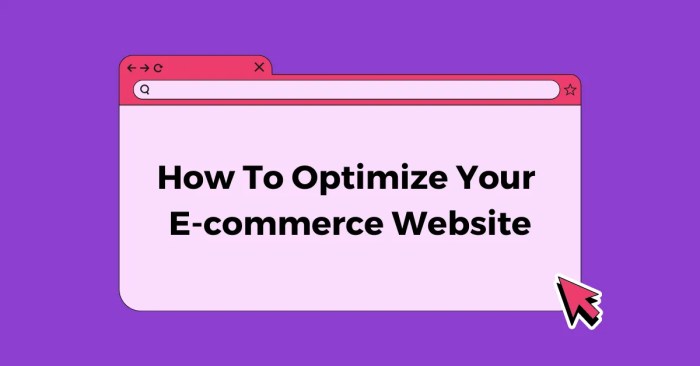E-commerce Website Optimization is the key to unlocking online success and achieving your business goals. Dive into the world of optimizing your e-commerce platform for maximum impact and growth.
Learn how to enhance user experience, implement winning strategies, and leverage powerful tools to take your e-commerce website to the next level.
Importance of E-commerce Website Optimization

Optimizing an e-commerce website is crucial for online success because it helps improve user experience, increase visibility, drive traffic, and ultimately boost sales. A well-optimized website ensures that potential customers can easily find products, navigate through the site seamlessly, and complete transactions without any hassle.
Key Benefits of E-commerce Website Optimization
- Improved Search Engine Ranking: By optimizing for relevant s and implementing best practices, e-commerce websites can rank higher in search engine results, leading to increased organic traffic.
- Enhanced User Experience: Optimization techniques such as faster loading times, mobile responsiveness, and intuitive navigation contribute to a positive user experience, resulting in higher engagement and conversion rates.
- Increased Conversions: Optimal website performance, clear product descriptions, persuasive call-to-actions, and streamlined checkout processes all contribute to higher conversion rates and ultimately more sales.
Successful Businesses Benefiting from Optimization, E-commerce Website Optimization
Amazon:
As one of the largest e-commerce platforms globally, Amazon’s continuous optimization efforts have helped them dominate the online retail space and provide a seamless shopping experience for customers.
Walmart:
With a focus on optimizing their website for mobile users, Walmart has seen significant growth in mobile sales and overall online revenue, showcasing the importance of mobile optimization in e-commerce.
Shopify:
As a leading e-commerce platform provider, Shopify’s emphasis on website optimization tools and features has enabled countless online businesses to enhance their online presence and drive sales effectively.
Factors to Consider for E-commerce Website Optimization
Optimizing an e-commerce website involves several key factors that are crucial for its success. From user experience to technical aspects, each element plays a significant role in ensuring the website performs at its best. Let’s delve into the essential factors to consider when optimizing an e-commerce website.
User Experience
User experience is a critical factor in e-commerce website optimization. A seamless and intuitive user interface can greatly impact customer satisfaction and retention. Factors such as easy navigation, clear product descriptions, and simple checkout processes can make a significant difference in converting visitors into customers.
(Search Engine Optimization)
Implementing effective strategies is vital for improving the visibility of an e-commerce website. By optimizing content, meta tags, and s, you can increase organic traffic and reach a wider audience. Additionally, creating high-quality backlinks and optimizing product images can further enhance the website’s search engine rankings.
Site Speed
Website speed is a critical factor in e-commerce website optimization. Slow loading times can lead to high bounce rates and decreased conversions. By optimizing images, minimizing HTTP requests, and leveraging browser caching, you can improve site speed and provide a better user experience.
Mobile Responsiveness
In today’s mobile-first world, ensuring your e-commerce website is mobile responsive is essential. With a growing number of users accessing websites on mobile devices, it’s crucial to optimize the website for various screen sizes and resolutions. A responsive design can enhance user experience and boost conversions.
Best Practices for E-commerce Website Optimization

When it comes to optimizing an e-commerce website, there are several best practices that can help enhance the overall user experience and drive more conversions.
Optimizing Product Pages
- Ensure fast loading times for product pages to prevent users from bouncing off.
- Optimize product descriptions with relevant s for better search engine visibility.
- Include high-quality images and videos to showcase products from different angles.
- Implement user-friendly navigation to help customers easily find what they are looking for.
- Add customer reviews and ratings to build trust and credibility with potential buyers.
Implementing a Secure Payment Gateway
Having a secure payment gateway is crucial for e-commerce websites to protect sensitive customer information and instill trust in online transactions. A secure payment gateway encrypts data to prevent unauthorized access, ensuring a safe and seamless checkout process for customers.
Role of High-Quality Images and Videos
High-quality images and videos play a significant role in optimizing product listings by providing customers with a visual representation of the products. Clear and detailed images help customers make informed purchase decisions, while videos can showcase products in action and highlight key features. Including multimedia content can enhance the overall shopping experience and increase engagement on product pages.
Tools and Technologies for E-commerce Website Optimization
In the world of E-commerce, optimizing your website is crucial for success. This involves analyzing data, tracking performance, and testing different strategies to improve user experience and increase conversion rates.
Popular Tools for Analyzing and Optimizing E-commerce Websites
- Google Analytics: A powerful tool for tracking website traffic, user behavior, and conversion rates. It provides valuable insights to make informed decisions for optimization.
- Hotjar: Allows you to visualize user behavior on your website through heatmaps, recordings, and surveys. This helps identify pain points and areas for improvement.
- Optimizely: A/B testing platform that enables you to test different variations of your website to see which performs better in terms of conversions.
Role of Analytics Tools in Tracking Website Performance and User Behavior
Analytics tools play a crucial role in monitoring the performance of your E-commerce website. By analyzing data such as traffic sources, bounce rates, and user engagement, you can identify issues and opportunities for optimization. These insights help you make data-driven decisions to improve the overall user experience and drive more conversions.
A/B Testing Tools for Optimizing Conversion Rates
- Split: Allows you to create A/B tests easily to compare different versions of your website and determine which one leads to higher conversion rates.
- VWO: Offers a user-friendly interface for setting up A/B tests and multivariate tests to optimize various elements of your website for better performance.
- Unbounce: Enables you to create and test landing pages to increase conversions and improve the overall effectiveness of your marketing campaigns.





